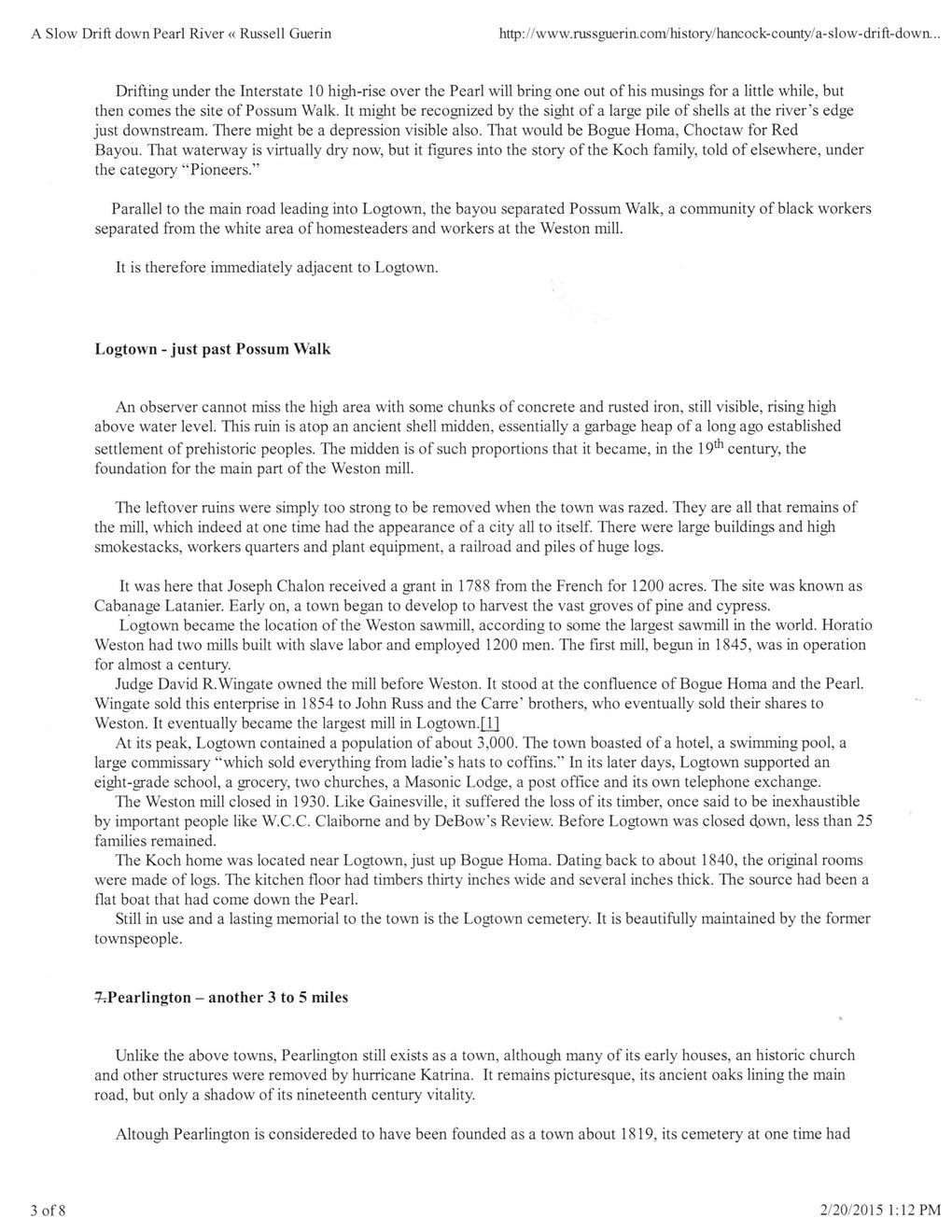This text was obtained via automated optical character recognition.
It has not been edited and may therefore contain several errors.
A Slow Drift down Pearl River « Russell Guerin http://www.russguerin.com/history/hancock-county/a-slow-drift-down.. Drifting under the Interstate 10 high-rise over the Pearl will bring one out of his musings for a little while, but then comes the site of Possum Walk. It might be recognized by the sight of a large pile of shells at the river’s edge just downstream. There might be a depression visible also. That would be Bogue Homa, Choctaw for Red Bayou. That waterway is virtually dry now, but it figures into the story of the Koch family, told of elsewhere, under the category “Pioneers.” Parallel to the main road leading into Logtown, the bayou separated Possum Walk, a community of black workers separated from the white area of homesteaders and workers at the Weston mill. It is therefore immediately adjacent to Logtown. Logtown - just past Possum Walk An observer cannot miss the high area with some chunks of concrete and rusted iron, still visible, rising high above water level. This ruin is atop an ancient shell midden, essentially a garbage heap of a long ago established settlement of prehistoric peoples. The midden is of such proportions that it became, in the 19th century, the foundation for the main part of the Weston mill. The leftover ruins were simply too strong to be removed when the town was razed. They are all that remains of the mill, which indeed at one time had the appearance of a city all to itself. There were large buildings and high smokestacks, workers quarters and plant equipment, a railroad and piles of huge logs. It was here that Joseph Chalon received a grant in 1788 from the French for 1200 acres. The site was known as Cabanage Latanier. Early on, a town began to develop to harvest the vast groves of pine and cypress. Logtown became the location of the Weston sawmill, according to some the largest sawmill in the world. Horatio Weston had two mills built with slave labor and employed 1200 men. The first mill, begun in 1845, was in operation for almost a century. Judge David R. Wingate owned the mill before Weston. It stood at the confluence of Bogue Homa and the Pearl. Wingate sold this enterprise in 1854 to John Russ and the Carre’ brothers, who eventually sold their shares to Weston. It eventually became the largest mill in Logtown.f 11 At its peak, Logtown contained a population of about 3,000. The town boasted of a hotel, a swimming pool, a large commissary “which sold everything from ladie’s hats to coffins.” In its later days, Logtown supported an eight-grade school, a grocery, two churches, a Masonic Lodge, a post office and its own telephone exchange. The Weston mill closed in 1930. Like Gainesville, it suffered the loss of its timber, once said to be inexhaustible by important people like W.C.C. Claiborne and by DeBow’s Review. Before Logtown was closed down, less than 25 families remained. The Koch home was located near Logtown, just up Bogue Homa. Dating back to about 1840, the original rooms were made of logs. The kitchen floor had timbers thirty inches wide and several inches thick. The source had been a flat boat that had come down the Pearl. Still in use and a lasting memorial to the town is the Logtown cemetery. It is beautifully maintained by the former townspeople. TrPearlington - another 3 to 5 miles Unlike the above towns, Pearlington still exists as a town, although many of its early houses, an historic church and other structures were removed by hurricane Katrina. It remains picturesque, its ancient oaks lining the main road, but only a shadow of its nineteenth century vitality. Altough Pearlington is considereded to have been founded as a town about 1819, its cemetery at one time had 3 of 8 2/20/2015 1:12 PM

Pearl River Document (003)